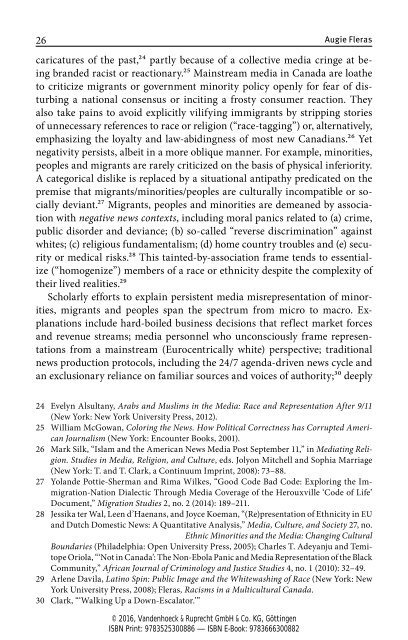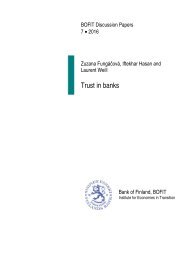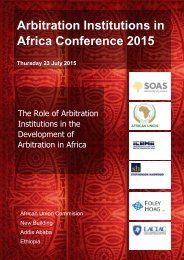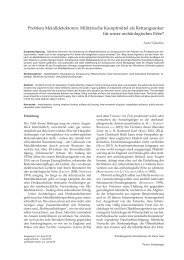Media and Minorities
9783666300882_ruhrmann_media_ebook_034247
9783666300882_ruhrmann_media_ebook_034247
You also want an ePaper? Increase the reach of your titles
YUMPU automatically turns print PDFs into web optimized ePapers that Google loves.
26<br />
Augie Fleras<br />
caricatures of the past,24 partly because of a collective media cringe at being<br />
br<strong>and</strong>ed racist or reactionary.25 Mainstream media in Canada are loathe<br />
to criticize migrants or government minority policy openly for fear of disturbing<br />
a national consensus or inciting a frosty consumer reaction. They<br />
also take pains to avoid explicitly vilifying immigrants by stripping stories<br />
of unnecessary references to race or religion (“race-tagging”) or, alternatively,<br />
emphasizing the loyalty <strong>and</strong> law-abidingness of most new Canadians.26 Yet<br />
negativity persists, albeit in a more oblique manner. For example, minorities,<br />
peoples <strong>and</strong> migrants are rarely criticized on the basis of physical inferiority.<br />
A categorical dislike is replaced by a situational antipathy predicated on the<br />
premise that migrants/minorities/peoples are culturally incompatible or socially<br />
deviant.27 Migrants, peoples <strong>and</strong> minorities are demeaned by association<br />
with negative news contexts, including moral panics related to (a) crime,<br />
public disorder <strong>and</strong> deviance; (b) so-called “reverse discrimination” against<br />
whites; (c) religious fundamentalism; (d) home country troubles <strong>and</strong> (e) security<br />
or medical risks.28 This tainted-by-association frame tends to essentialize<br />
(“homogenize”) members of a race or ethnicity despite the complexity of<br />
their lived realities.29<br />
Scholarly efforts to explain persistent media misrepresentation of minorities,<br />
migrants <strong>and</strong> peoples span the spectrum from micro to macro. Explanations<br />
include hard-boiled business decisions that reflect market forces<br />
<strong>and</strong> revenue streams; media personnel who unconsciously frame representations<br />
from a mainstream (Eurocentrically white) perspective; traditional<br />
news production protocols, including the 24/7 agenda-driven news cycle <strong>and</strong><br />
an exclusionary reliance on familiar sources <strong>and</strong> voices of authority;30 deeply<br />
24 Evelyn Alsultany, Arabs <strong>and</strong> Muslims in the <strong>Media</strong>: Race <strong>and</strong> Representation After 9/11<br />
(New York: New York University Press, 2012).<br />
25 William McGowan, Coloring the News. How Political Correctness has Corrupted American<br />
Journalism (New York: Encounter Books, 2001).<br />
26 Mark Silk, “Islam <strong>and</strong> the American News <strong>Media</strong> Post September 11,” in <strong>Media</strong>ting Religion.<br />
Studies in <strong>Media</strong>, Religion, <strong>and</strong> Culture, eds. Jolyon Mitchell <strong>and</strong> Sophia Marriage<br />
(New York: T. <strong>and</strong> T. Clark, a Continuum Imprint, 2008): 73–88.<br />
27 Yol<strong>and</strong>e Pottie-Sherman <strong>and</strong> Rima Wilkes, “Good Code Bad Code: Exploring the Immigration-Nation<br />
Dialectic Through <strong>Media</strong> Coverage of the Herouxville ‘Code of Life’<br />
Document,” Migration Studies 2, no. 2 (2014): 189–211.<br />
28 Jessika ter Wal, Leen d’Haenans, <strong>and</strong> Joyce Koeman, “(Re)presentation of Ethnicity in EU<br />
<strong>and</strong> Dutch Domestic News: A Quantitative Analysis,” <strong>Media</strong>, Culture, <strong>and</strong> Society 27, no.<br />
Ethnic <strong>Minorities</strong> <strong>and</strong> the <strong>Media</strong>: Changing Cultural<br />
Boundaries (Philadelphia: Open University Press, 2005); Charles T. Adeyanju <strong>and</strong> Temitope<br />
Oriola, “‘Not in Canada’: The Non-Ebola Panic <strong>and</strong> <strong>Media</strong> Representation of the Black<br />
Community,” African Journal of Criminology <strong>and</strong> Justice Studies 4, no. 1 (2010): 32–49.<br />
29 Arlene Davila, Latino Spin: Public Image <strong>and</strong> the Whitewashing of Race (New York: New<br />
York University Press, 2008); Fleras, Racisms in a Multicultural Canada.<br />
30 Clark, “‘Walking Up a Down-Escalator.’”<br />
© 2016, V<strong>and</strong>enhoeck & Ruprecht GmbH & Co. KG, Göttingen<br />
ISBN Print: 9783525300886 — ISBN E-Book: 9783666300882







